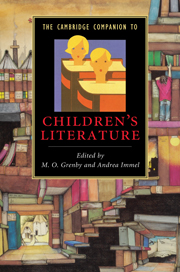10 - Children’s texts and the grown-up reader
from Part II - Audiences
Published online by Cambridge University Press: 28 November 2010
Summary
It is a truth still insufficiently acknowledged that our finest children's books are hybrid constructs that combine a child's perspective with the guarded perspective of the former child we call 'adult'. Pliable and elastic, such mixed texts allow both perspectives to coexist. They may rely on a fictional child/adult amalgam, or an animal/human composite, such as a Sendakian Wild Thing, as a mediating agent. Or they may require a transformative space that is both mundane and fantastic, as ordinary as a smelly barn and as magical as the mysterious advertising slogans that a tiny spider called Charlotte has spun on her threshold web.
Since it has become routine for critics to scrutinise adult values embedded in juvenile texts, we may no longer need Jacqueline Rose to remind us that children's literature is not 'something self-contained' or exclusively self-referential. Nonetheless, our scrupulous attention to cultural and political frames has hardly moved us beyond Rose's dialectical emphasis on generational binaries. The overlaps and frictions that make most children's books such an interactive meeting ground for readers of different ages still require a much closer attention.
- Type
- Chapter
- Information
- The Cambridge Companion to Children's Literature , pp. 159 - 173Publisher: Cambridge University PressPrint publication year: 2009
- 1
- Cited by



